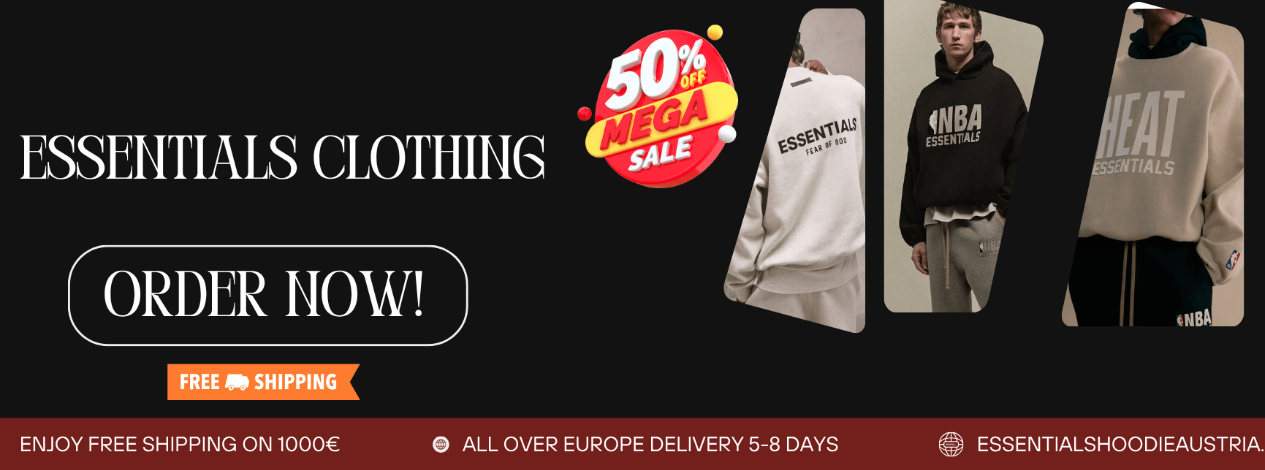How Essentials Became a Streetwear Powerhouse

Introduction
In the ever-evolving world of fashion, very few brands manage to capture the sweet spot between minimalism, accessibility, and streetwear credibility. Essentials—a diffusion line of Jerry Lorenzo’s Fear of God—has done just that. What began as a more affordable, pared-down counterpart to a luxury streetwear label has transformed into a global phenomenon. From Los Angeles street corners to Tokyo boutiques, Essentials has cemented itself as a streetwear powerhouse. Its rise is a case study in understanding the modern consumer’s hunger for quality basics infused with cultural relevance.
1. The Birth of Essentials
The story begins with Fear of God, Essentials Hoodie Jerry Lorenzo’s brainchild founded in 2013. The parent label quickly gained traction for its oversized silhouettes, luxury fabrics, and high price points, attracting celebrities like Kanye West, Justin Bieber, and Kendall Jenner.
But Lorenzo saw a gap in the market: not everyone could afford a $900 hoodie, yet many wanted that same Fear of God aesthetic. In 2018, Essentials was born—offering minimalist streetwear at a fraction of the price. The name itself was intentional: these were wardrobe “essentials,” pieces meant to be worn daily without losing their fashion edge.
2. The Design Philosophy
Essentials’ design ethos revolves around simplicity, comfort, and versatility. Pieces are often neutral-toned—think beige, black, cream, and grey—with minimal branding aside from the signature rubberized label or reflective “Essentials” logo.
Lorenzo’s approach to design is about uniform dressing—creating a wardrobe where each piece complements the other. Oversized hoodies, relaxed sweatpants, heavyweight T-shirts, and zip-up jackets form the backbone of the brand. These silhouettes resonate with both fashion enthusiasts and casual wearers because they bridge the gap between luxury streetwear and everyday comfort.
3. Clever Positioning in the Streetwear Market
Streetwear thrives on exclusivity and hype, but Essentials balances this with accessibility. Instead of ultra-limited drops that sell out in minutes, Essentials releases seasonal collections in collaboration with major retailers like PacSun, Mr Porter, and SSENSE.
This model allows the brand to:
- Maintain hype through anticipated seasonal drops.
- Keep prices within reach for a larger audience.
- Distribute globally without losing its streetwear appeal.
The brand’s ability to create scarcity while remaining obtainable is a marketing masterstroke. Essentials doesn’t compete directly with ultra-luxury labels; instead, it owns the middle ground.
4. The Role of Celebrity Influence
From day one, Essentials benefited from celebrity co-signs. Stars like Justin Bieber, Hailey Bieber, and Luka Sabbat have been spotted in Essentials hoodies and sweatpants, often paired with designer sneakers. This visibility fuels the brand’s desirability—especially on social media, where influencer culture thrives.
The connection between Lorenzo and high-profile celebrities isn’t accidental. He built his career styling athletes and artists, and those relationships naturally extended to Essentials. Each celebrity sighting acts as an organic advertisement, reinforcing Essentials’ image as a brand that blends luxury aesthetics with everyday practicality.
5. The Pandemic Boost
The COVID-19 pandemic unexpectedly accelerated Essentials’ rise. As the world shifted to remote work and loungewear became the new norm, consumers sought stylish yet comfortable clothing. Essentials’ oversized hoodies, cozy sweatpants, and muted color palettes fit the bill perfectly.
Online demand surged, with many drops selling out within hours. Social media platforms like TikTok and Instagram amplified the hype, as influencers showcased “Essentials hauls” and outfit inspiration videos. This period solidified the brand’s association with premium comfort wear.
6. Collaborations and Cultural Touchpoints
While Essentials operates mostly as a standalone line, it has strategically partnered with retailers and select collaborators that align with its image. These partnerships expand the brand’s reach without diluting its identity.
PacSun, in particular, has become almost synonymous with Essentials. The retailer’s online and in-store drops are often the go-to for fans, creating a consistent distribution point that feels exclusive yet accessible. Essentials has also tapped into sneaker culture by releasing apparel that pairs seamlessly with popular Nike and Adidas silhouettes, making it a staple for sneakerheads.
7. Global Appeal
One reason Essentials has become a streetwear powerhouse is its cross-cultural adaptability. Neutral tones and minimalist branding make the line universally appealing, while oversized silhouettes align with fashion trends in markets like Japan, South Korea, and Europe.
In Asian streetwear hubs, Essentials is viewed as an import luxury, while in the U.S., it sits comfortably alongside mid-tier and premium streetwear brands. This versatility allows the brand to transcend regional fashion preferences and maintain a global fan base.
8. The Secondary Market and Hype Economy
A true sign of streetwear dominance is resale value. Essentials Sweatpants Essentials’ most popular items—like the core hoodies or “Fear of God” printed sweatshirts—often resell for 1.5x to 3x their retail price on platforms like StockX and Grailed.
This resale activity doesn’t just reflect demand; it reinforces the brand’s hype cycle. Fans who miss out on retail drops turn to secondary markets, which keeps Essentials’ perceived value high and ensures it remains a “must-have” in streetwear circles.
9. Balancing Growth and Exclusivity
Many brands struggle when scaling up—too much availability can kill hype. Essentials has managed to grow rapidly while keeping its desirability intact. The key? Seasonal refreshes and controlled production runs.
By introducing slight changes in colorways, fit, and fabric, Essentials keeps each drop feeling fresh. Even if silhouettes repeat, limited seasonal palettes make older collections feel rare and collectible.
10. The Future of Essentials
As the streetwear market matures, Essentials is well-positioned to remain a major player. The brand’s future may include:
- Expanding its women’s and kids’ lines.
- Exploring footwear or accessories.
- Increasing presence in global luxury department stores.
- Potential sustainable fabric initiatives to appeal to eco-conscious consumers.
What’s clear is that Essentials has carved out a unique identity—luxury-inspired, minimal, comfortable, and culture-driven. It’s not just a diffusion line anymore; it’s a cultural force in its own right.
Conclusion
Essentials’ rise from a Fear of God sub-label to a global streetwear powerhouse didn’t happen by chance. It’s the product of strategic pricing, minimalist design, celebrity influence, and savvy market positioning. In a fashion landscape where trends shift overnight, Essentials has found a way to remain timeless yet relevant—proving that sometimes, less really is more.
From its carefully curated collections to its loyal fanbase, Essentials embodies the modern streetwear dream: accessible luxury for the everyday wardrobe, backed by cultural clout. As long as the appetite for stylish comfort exists, Essentials will likely stay at the top of the streetwear conversation


